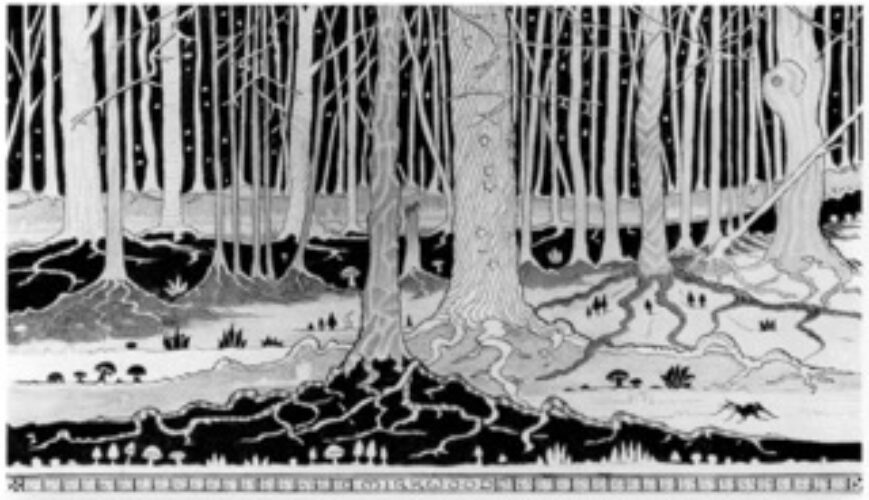Mirkwood (I: The Woodland Realm)

- Name: Mirkwood, Greenwood, Eryn Galen (Sindarin: green wood), Taur-nu-Fuin (Sindarin: forest under night), Taur-e-Ndaedelos (Sindarin: Forest of the Great Fear), Eryn Lasgalen (Sindarin: greenleaf wood)
- Description: A huge forest that splits Wilderland in half, ranging from 200 to 300 miles east-to-west and about 600 miles north-to-west. Dwarfs eastern neighbors Erebor and the Iron Hills, which look like serfs levied with small plots of land. Surrounded by the Misty Mountains and Grey Mountains.
Encompasses the Forest River and Enchanted River, with the Celduin running through its eastern border. An Old Forest Road, Men-i-Naugrim, is lost by The Hobbit’s time, while an enchanted elf path remains. The Emyn-nu-Fuin, Dark Mountains, are roughly in its north-central region, south of the Woodland Realm of the Wood-elves.
In the south, the East Bight chomps into Mirkwood, creating the Narrows of the Forest. The southwest corner houses Dol Guldur, sometime-home of Sauron and the Nazgûl. The Forest River and an enchanted river also run through Mirkwood. - Locations in Peter Jackson films: Te Anau, South Island (Mirkwood Gate), Pelorus River, South Island (Forest River), Stone Street Studios (Thranduil’s caverns)
Less a geographic location than a metonym for Middle-earth’s unfinished tale, Mirkwood is a classic fairy tale forest that defines those forests. Its iconic appearance in The Hobbit which it profoundly changes is only one aspect of its story. Many characters and texts have their own Mirkwoods. This derivé will stray out of thought and time, and wander far on roads only we shall tell. It’s up to us to find a guide through it.

Mirkwood is too large and complex to be one thing. John D. Rateliff points out that Mirkwood marries “two archetypes: The Dark Wood and The Enchanted Forest.” Similarly, John Garth writes “Mirkwood is a portmanteau forest of forests.” Even the name “Mirkwood” is of early provenance, having been applied to a number of historical and legendary forests. Since its name doesn’t belong to only one place, Mirkwood exists in a state of identity crisis, with factions and traditions battling over their different visions of the forest.
In The Hobbit, Mirkwood has been effectively conquered by the gothic. The book shows Mirkwood as a divided primal forest with elements of gothic horror, so dark that it’s “not what you call pitch-dark, but really pitch.” The wood is festooned in “dark dense cobwebs with threads extraordinarily thick”, populated by “black moths, some nearly as big as your hand”, heretofore unknown butterfly species, and giant spiders. Bilbo and the dwarves walk among “dead leaves of countless other autumns.” It’s a Brothers Grimm-esque scary forest, the sort of place where stepping on the wrong plant could be fatal.
Where Tolkien innovates is that Mirkwood’s darkness is a symptom of sickness. Mirkwood is suffering from Sauron’s presence. In The Desolation of Smaug, Bilbo observes that Mirkwood “feels sick, as if a disease lies upon it.” The Necromancer, or Sauron, is a foreign presence plotting his return to prominence by poisoning verdant nature.…
